Walking Shikoku (and Biking the Shimanami Kaido)
Letters from Japan, April 2025: a walk along the southern coast of Shikoku, one night in Matsuyama and biking the Shimanami Kaido.
Good afternoon,
We are on the last day of yet another national holiday in Japan: the beloved Golden Week, which owes its celebratory name to the four public holidays that fall within a single week, resulting in a roughly ten-day office closure for some workplaces like mine. It’s also the time when 23 million people are expected to be traveling within and outside of Japan. As a result, Japan Railways requires seat reservations for most Shinkansen lines (even those departing every six minutes) as trains are typically sold out at the beginning and end of the week. It’s possibly the biggest travel week in the country.
And this year, I joined the many millions of domestic travelers filling the airplane and Shinkansen seats. While today is rainy across the entire country, including Tokyo, we were blessed with sunny skies and mild temperatures for most of Golden Week, marking one last opportunity for long walks before the rainy season, and then the season from hell (summer, aka the time when, even if the humidity doesn’t kill you, it certainly doesn’t make you stronger) descends upon us, forcing as much indoor time as possible just for the sake of staying alive.
To make the most of this brief window of too-good-to-be-true weather,1 I spent the first eight days of the break walking the southern coast of Shikoku, followed by a very short but memorable stay in Matsuyama City and returning to the “main island” with a two-day bike trip along the Shimanami Kaido (the 70-kilometer-long cycling route that crosses six islands and seven bridges along the Seto Inland Sea, connecting Shikoku to Honshu) giving me a chance to finally write about a region of Japan I deeply adore but have somehow mentioned very little in this newsletter.
So, this month’s letter is an overview of the Golden Week trip. Since a diary-style post, like the previous Kyoto sakura trip diary, covering all the stops would make this letter excruciatingly long, I’ll be sharing separate posts including a more detailed itinerary and logistical detail: first about the Shimanami Kaido in May, followed by the Shikoku walk in June, under the travel diaries section available to monthly and annual subscribers.
A walk along the southern coast of Shikoku
Shikoku, the smallest of Japan’s four main islands and made up of four prefectures, namely Tokushima, Kochi, Ehime, and Kagawa, is best known for the 88-Temple Pilgrimage Route, which takes about six weeks to complete on average. A close study of the route often leads to a brief phase of disappointment for walkers, since roughly 80% of the 1,200-kilometer journey involves roadside walking (a common reality for most long-distance trails in Japan), with only limited sections through mountain passes, forests, and beaches. Still, many people describe the experience, which involves visiting each of the 88 temples associated with Kobo Daishi (founder of the Shingon sect of Buddhism in Japan) with opportunities to stay overnight at some of the temples, as transformative. I’ve previously walked parts of the route, focusing on the more picturesque mountaintop temples, and I’d love to complete the full walk one day.
However, this recent trip to Shikoku had little to do with the Pilgrimage Route. My focus was the coast of Kochi Prefecture, which is home to fewer of the official pilgrimage temples, but offers an array of other human-made and natural sites with the promise to enrich any walking trip.
In addition to the side visit opportunities, there were a few other reasons why I chose the southern coast of Shikoku for this walking trip. First, after the Great Ocean Walk experience in Australia during last year’s May break, my first ocean-side long hike, which made me both explosively but at the same time calmingly happy, leading me to describe it as the hike of my life, I was looking for similar coastal walks.
Second, I was already familiar with the southern coast of Shikoku Prefecture, having once stayed at Kongofukuji Temple, iconically positioned on Cape Ashizuri right behind a lighthouse perched above a cliff beaten by violent waves (a perfect setting for a suspense movie with a religious theme, a little à la The Name of the Rose). This was very shortly after I moved to Japan, at the generous invitation of a friend from Tokyo whose father is the head priest of the temple and whose family lives on the premises. Thanks to that first trip, which happened to take place during peak August humidity and therefore involved sightseeing by car rather than walking, I already knew how beautiful the region was—but more importantly, how walkable it was (under less humid weather conditions).
Planning the route was also a fairly straightforward process, as I stayed in the same area—Cape Ashizuri—for all six days2 and took the bus to the starting point of the walk each day, sticking to the coastal section throughout. Some parts of the route were also part of the Shikoku Nature Trail, a patchwork of hiking trails across the island, with narrow forest sections running right next to the ocean and helpful signage along the way, which made things easier.
Each day involved an average of five hours of walking, usually preceded by a one-hour round-trip walk to the Ashizuri Lighthouse for sunrise. While I had initially contemplated walking seven to eight hours a day, five turned out to be just right, as the asphalt roads left my feet more sore and my body more tired than much longer and steeper mountain hikes on softer terrain.
One thing that felt especially rewarding was that there was always something interesting along the way, including some of the most picturesque abandoned buildings I’ve seen—like the Dragon Palace, which I understand is quite famous among ruin hunters. Some of the beaches I passed (like Oki Beach) were enlivened by surfers, though they seemed a little disappointed by the small waves, while the rocky sections of the shore hosted many oyster hunters. Other highlights included Hakusan-Domon, a sea cave with a large arch; the recently renovated Ashizuri Aquarium—where I watched a puppy on her owner's lap admiring a sea lion; several scenic lighthouses, and last but not least, the Ryugu oceanside shrine, which is best visited in the late afternoon, when the ever-changing cloud formations reflect beautifully on the tiny oceanwater ponds formed among the rocks.
After a long break, being back in Shikoku was wonderful—not only for the beautiful scenery but also for the chance to reflect on my years in Japan: how my view of the country has evolved, and how I relate to it (or fail to), sometimes more strongly, sometimes with a strange sense of disconnect, by comparing my reaction to the same place between two different visits.
The first time I was in Shikoku, I remember feeling shell-shocked by the depopulation rural areas were facing, with obvious signs everywhere: abandoned buildings and barely a person out on the streets. It was the most apocalyptic scenery I had ever experienced—so much so that it might have felt a little scary, if it weren’t for the known safety of Japan. The beauty of the landscape was certainly there, but it took quite an effort to appreciate it, moving past the initial shock of the ghost-town atmosphere.
But this time, everything felt strangely normal, to the point that I almost felt immune to the ghostly emptiness (and without meaning to undermine the adverse impact of de-population on the region, even enjoyed it). I was far beyond the shock phase, which gave me the space to focus more on the visual beauty of some of the abandoned buildings, to feel okay relying on the slim chance that a restaurant marked as open on Google Maps actually would be open, rather than greeting me with a plant-covered façade and a door likely shut for the last time years ago, after walking an hour to reach it. I also no longer felt sad about the narrow wooden houses all seemingly on the verge of collapse, even as laundry hung from every window as a sign of life, but instead appreciated their absurd aesthetic appeal.
Matsuyama: what a lovely surprise
My feelings about my next stop also generously benefited from the perspectives Japan has granted me over the past few years.
The only reason I visited Matsuyama City, the main city in Ehime Prefecture, Shikoku, was logistical: to have an early and comfortable evening after a seven-hour trip, before starting the Shimanami Kaido bike ride the next day, as the city sits just a 30-minute train ride from the route’s starting point in Imabari. But the kilometer-long shōtengai and the perfectly lit narrow streets lined with atmospheric izakaya led me to walk for hours to better soak up the atmosphere (and some wine), turning it into anything but an early night.
I don’t think I would have properly appreciated a city like Matsuyama if it had been my first time traveling in Japan (or if I did, it would be for very different reasons). But with the experience of the past few years, I now recognize how these mid-sized cities, located in an otherwise heavily rural region, showcase some of the best of what Japan has to offer: compact, completely walkable, full of character, with enough sights to keep you entertained without making you feel overwhelmed, and with easy access to nature and rural areas. The mood of the town reminded me of Kagoshima in Kyushu, a gateway to Yakushima Island, but also a very worthy stop in its own right. And in the case of Matsuyama, there's the added bonus of the city being home to one of Japan’s twelve remaining original castles.
Shimanami Kaido: six islands, seven bridges
I wrapped up the trip by (re) biking the Shimanami Kaido Cycling Route, this time covering the 70-kilometer route over two days with an overnight stay on Omishima Island at I-Link Hostel,3 which sits right at the midway point of the route. I can’t recommend this hostel enough, where you can book a private room for just 3,000 yen extra, and the 1,900 yen set dinner was a feast: a vegetable entrée plate, salad, soup, and multiple main dish choices.
Unlike my first ride, when I biked the entire route in one day from Onomichi to Imabari, driven by excitement to reach the Kurushima-Kaikyō Bridge, the final and most anticipated section, this time I cycled in the opposite direction, starting from Imabari in Shikoku and ending in Onomichi to catch the Shinkansen back to Tokyo.
While the Shimanami Kaido may not be the most spectacular biking route in terms of scenery, it’s certainly a very enjoyable way to spend a few days exploring the Setouchi Islands. The route takes you across seven bridges, including Kurushima-Kaikyō, which was once the longest suspension bridge in the world, and passes through six islands, with plenty of detour options along the way. Among the six islands on the route (Oshima, Omishima, Ikuchi, Hakata, Innoshima, and Mukaishima), I spent the most time on Ikuchi Island. It offers some of that charming fishing village atmosphere and is also home to Kōsan-ji, one of the strangest temples I’ve visited in Japan. Founded by a businessman, it reminded me more of Chinese temples (which I find to be very beautiful but felt a little out of place in Japan) than Japanese ones. The island also hosts the Hirayama Ikuo Museum, which features the works of the late painter.
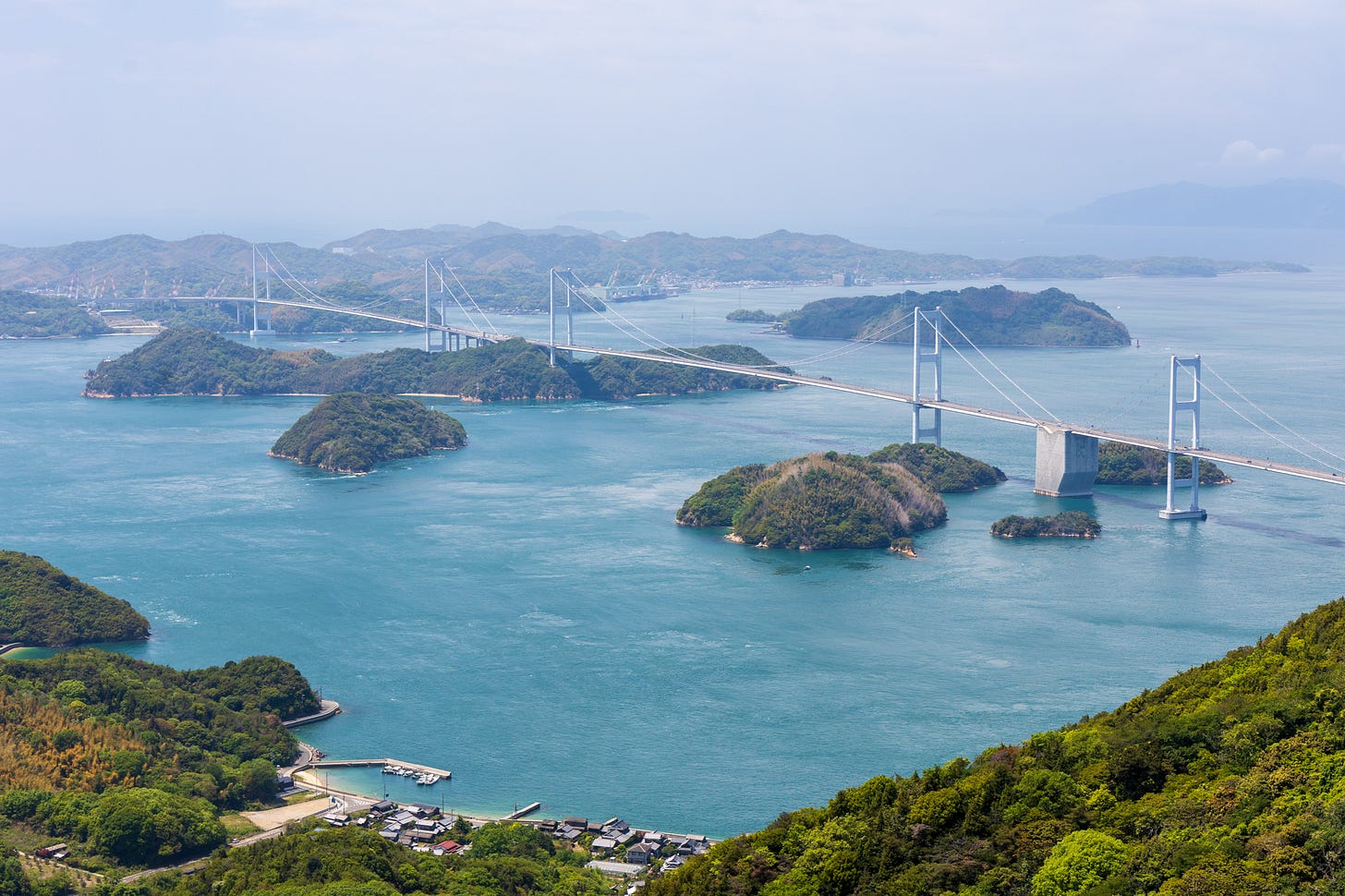
The Shimanami Kaido benefits from excellent visitor infrastructure, with online bike rental options, including cross bikes, road bikes, e-bikes, and even tandem bikes (which always look excruciatingly difficult). Rentals can be dropped off at various points along the route, including at the opposite end of the trail. The cycling path is very well signposted, and there’s a good mix of eateries, accommodations, and, of course, convenience stores along the way. I think, along with the Nakahechi Route of the Kumano Kodo, the Shimanami Kaido is one of the few outdoor experiences in Japan where the logistics are so well thought out that you can focus your energy entirely on enjoying the route (and pedaling, of course).
Also, the route isn’t particularly demanding. I’m certainly not a strong cyclist (honestly, I don`t even like biking that much if not for the opportunities like this) and tend to feel over-dramatically depressed whenever a climb appears when I’m on a bike, so if I managed it comfortably, chances are most people can too.
With this latest trip, preceded by an extended non-travel period in Tokyo (except for the brief Kyoto sakura outing), and the chance to see some friends I hadn’t seen in nearly a decade, this has been a lovely spring.
The next trip, which begins in a few days, will take me to Belgrade (Serbia) for work, a city I’ve never visited but have heard great things about. My colleague and I will be flying with Turkish Airlines, as there are no direct flights between Tokyo and Belgrade, and the Istanbul connection works out best logistically (and, for me, emotionally and gastronomically). I am happy that I have been granted permission for a 36-hour stopover in Istanbul on the return trip to Tokyo over the weekend.
In addition to more detailed diary-style posts (one for the Shimanami Kaido and one for the Shikoku walk, available to monthly and annual subscribers), I’ll be back in late May, possibly focusing on the Kuju Mountains, if I can make the annual azalea hike.
As always, thank you for being here. I hope you're enjoying a lovely spring—or autumn, depending on where you are.
Until next time,
Burcu
One thing I had to quickly learn in Japan is to book all travel, including trains, airfares, and accommodation, as fully refundable, as the weather is highly volatile and often requires changes to outdoor-focused travel plans.
I stayed in two different hotels and both were great: decades old but regularly renovated and well maintained - Ashizuri Thermae and the Mana Village.
Back in 2019, I stayed at the lovely Shiomi House on Sashima Island, a traditional old Japanese house offering both dormitory and private rooms. While I would have loved to stay there again, reaching the island requires an additional ferry detour, which would have added some logistical complications this time.


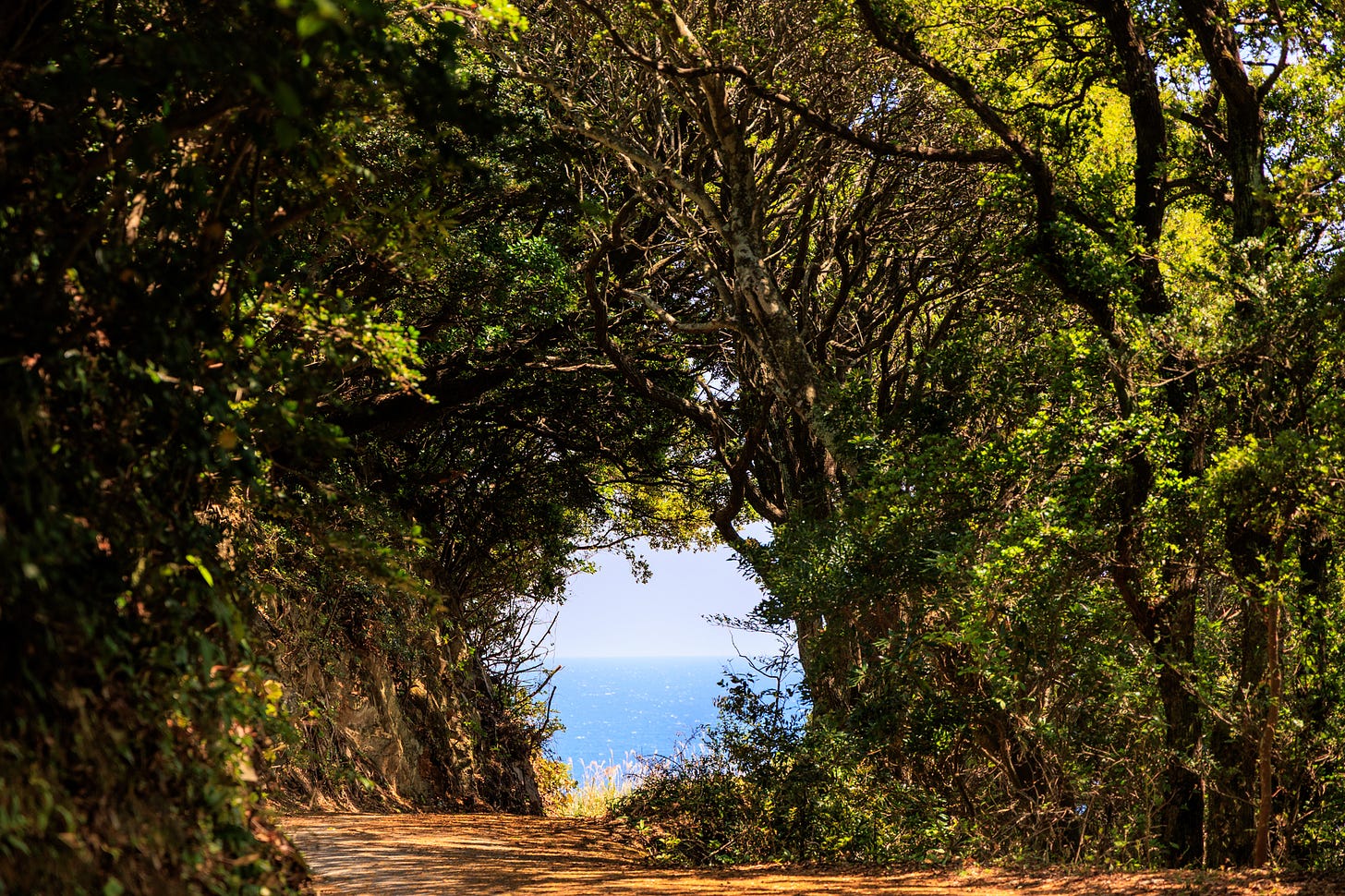
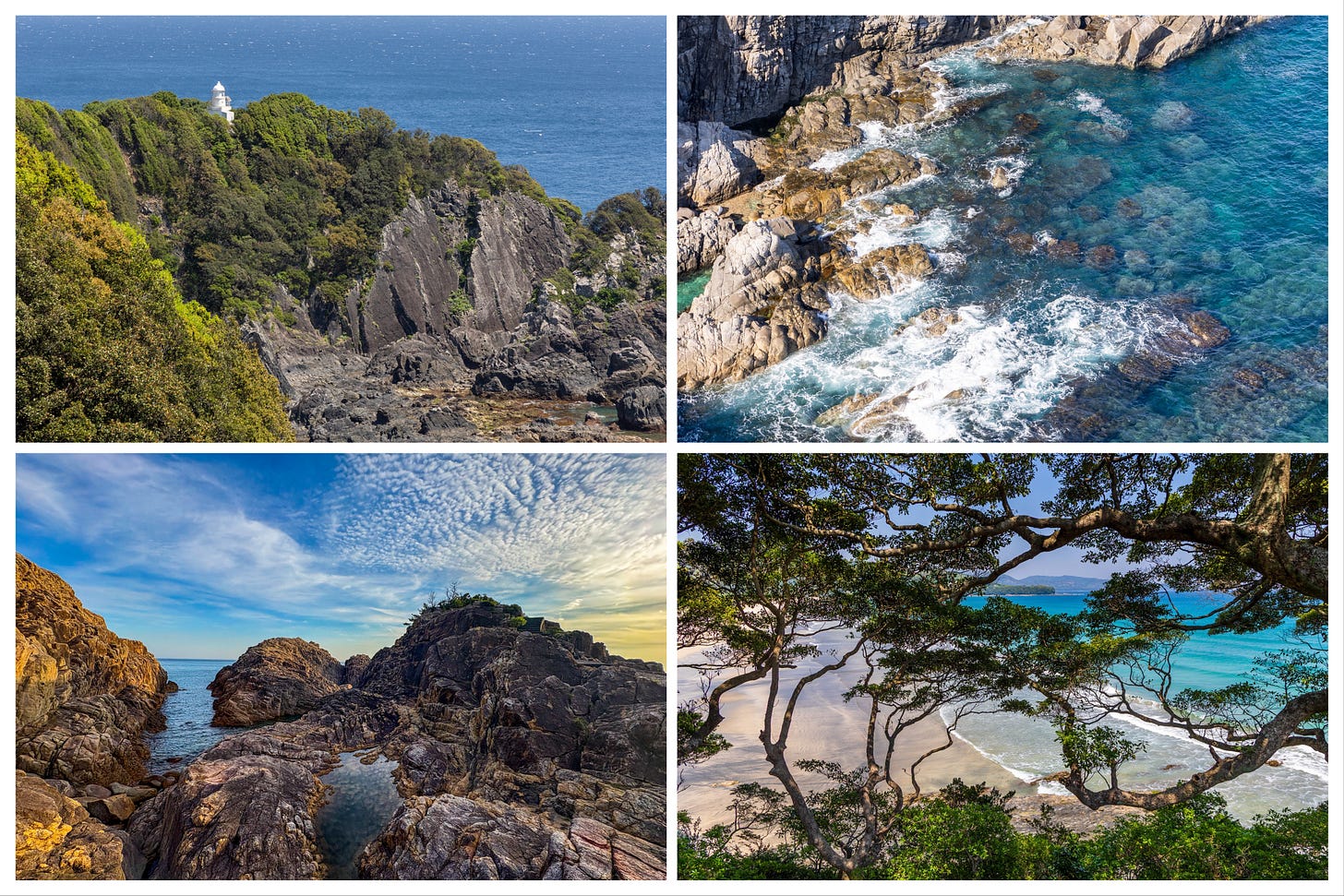
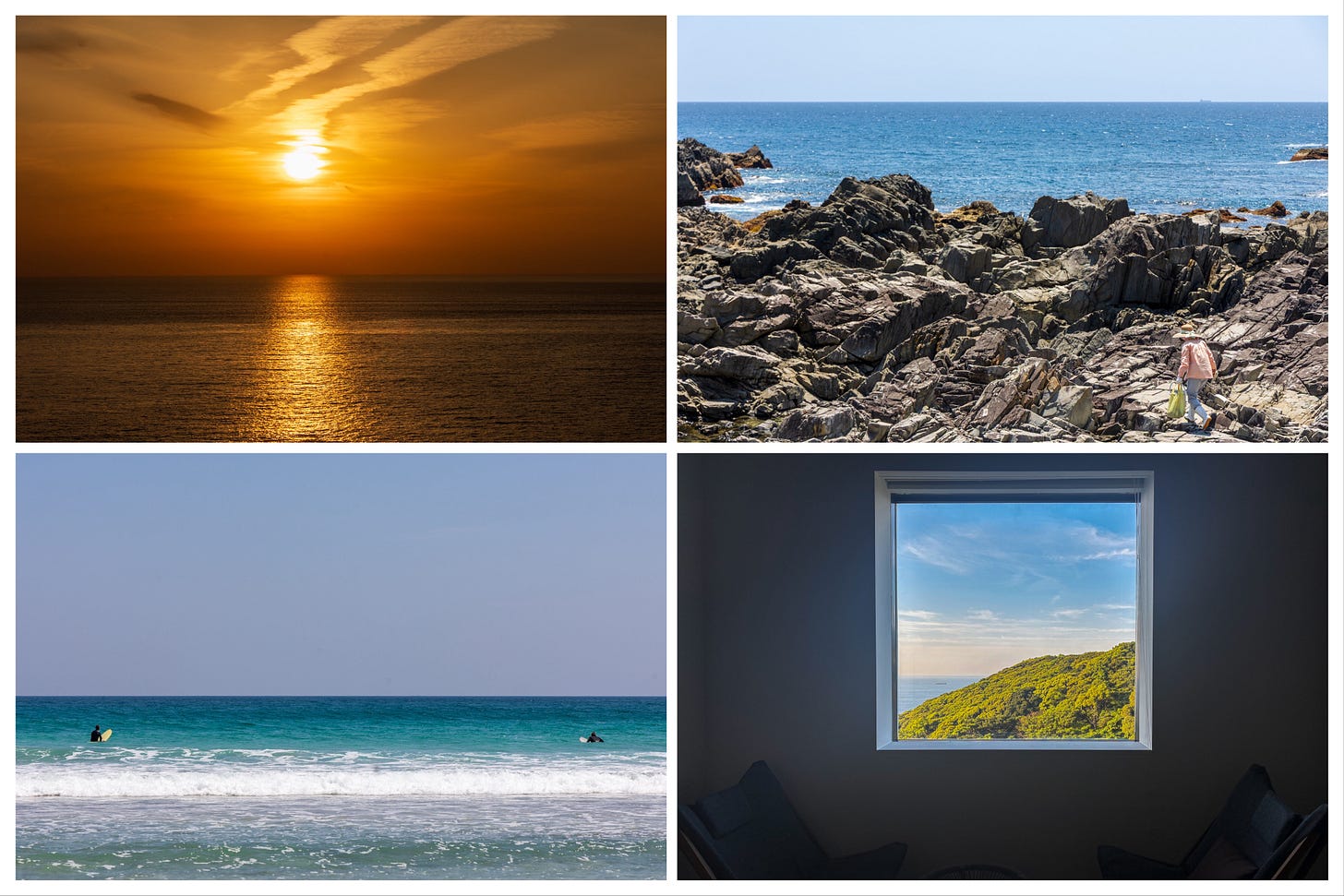
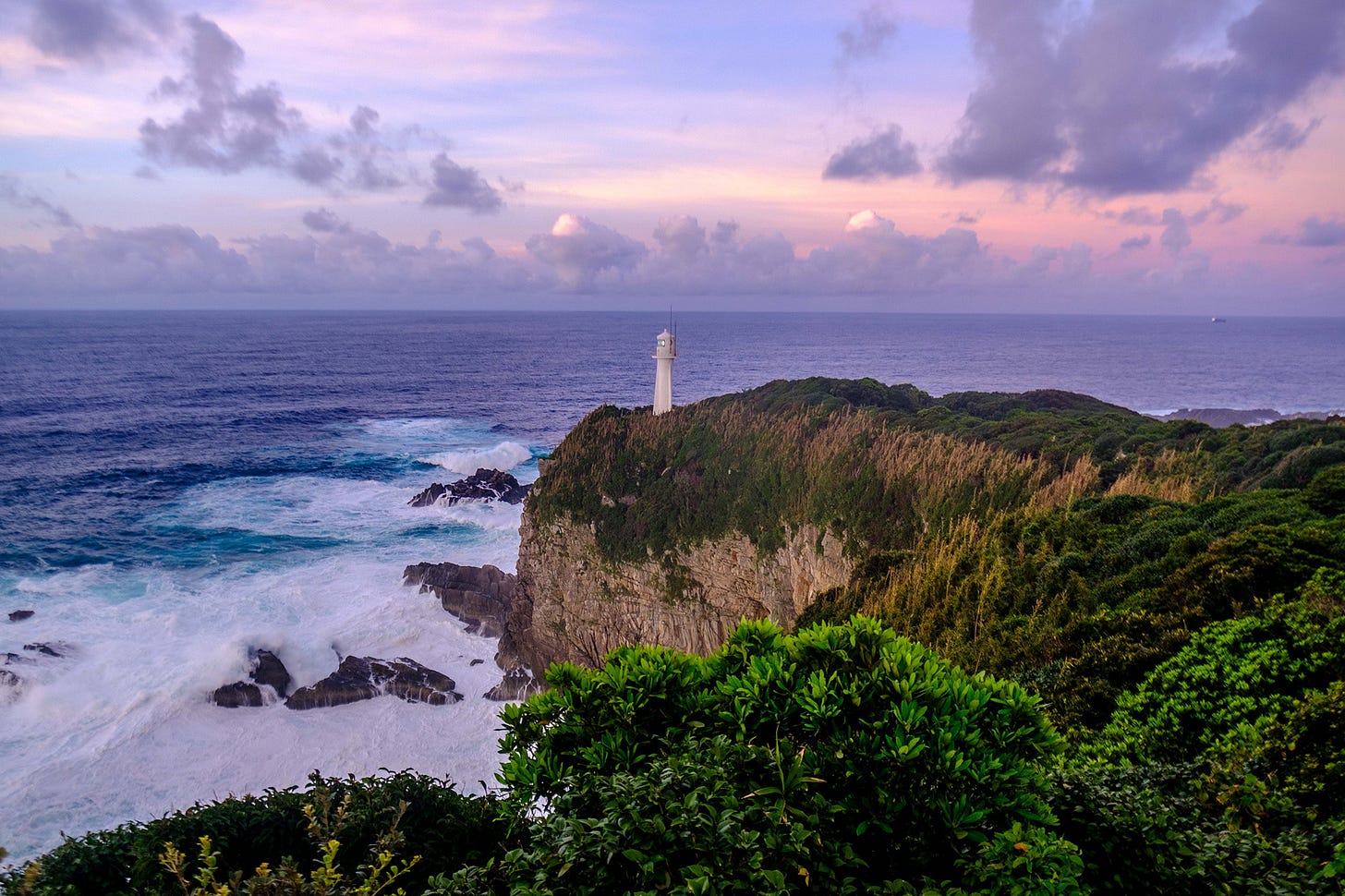
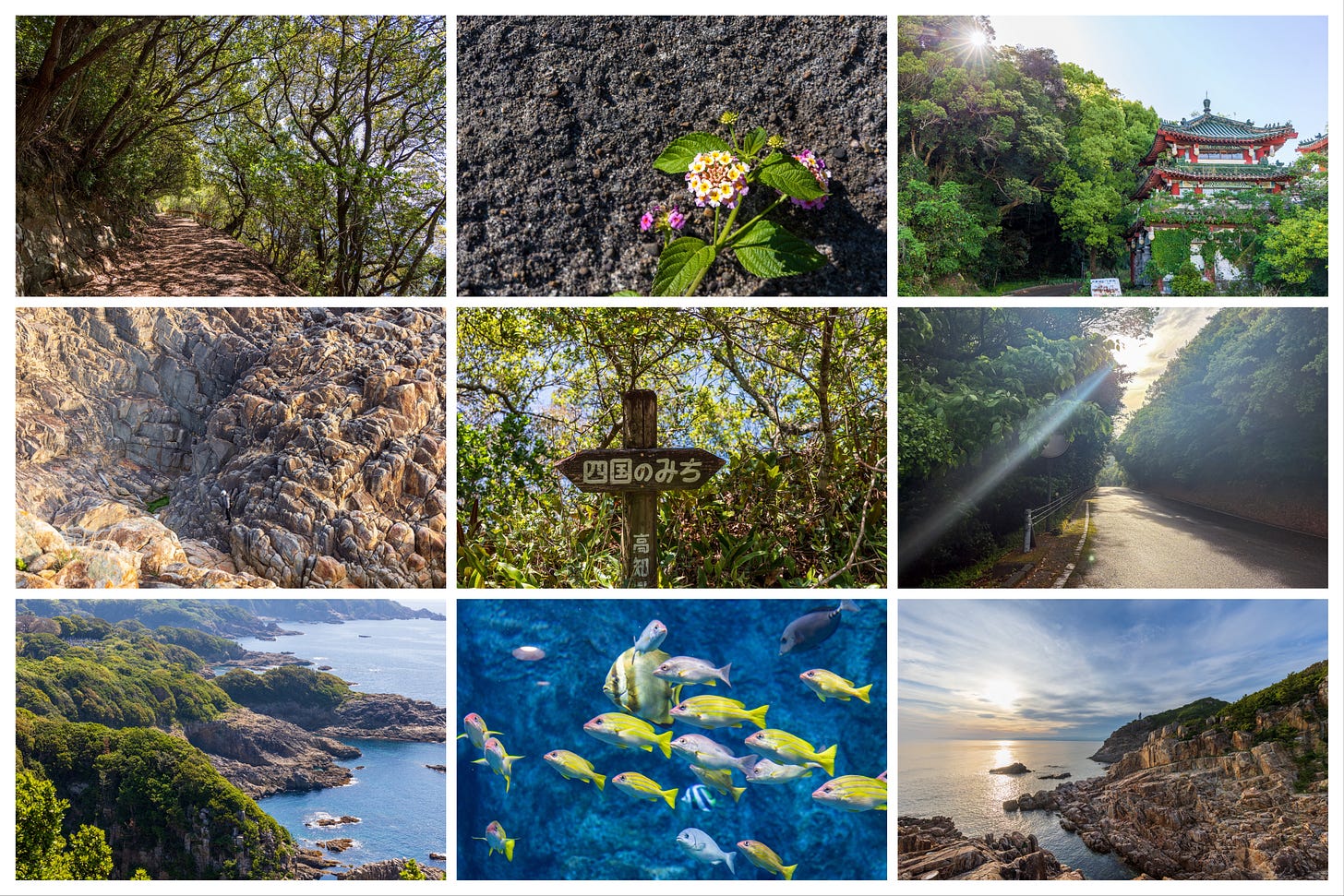
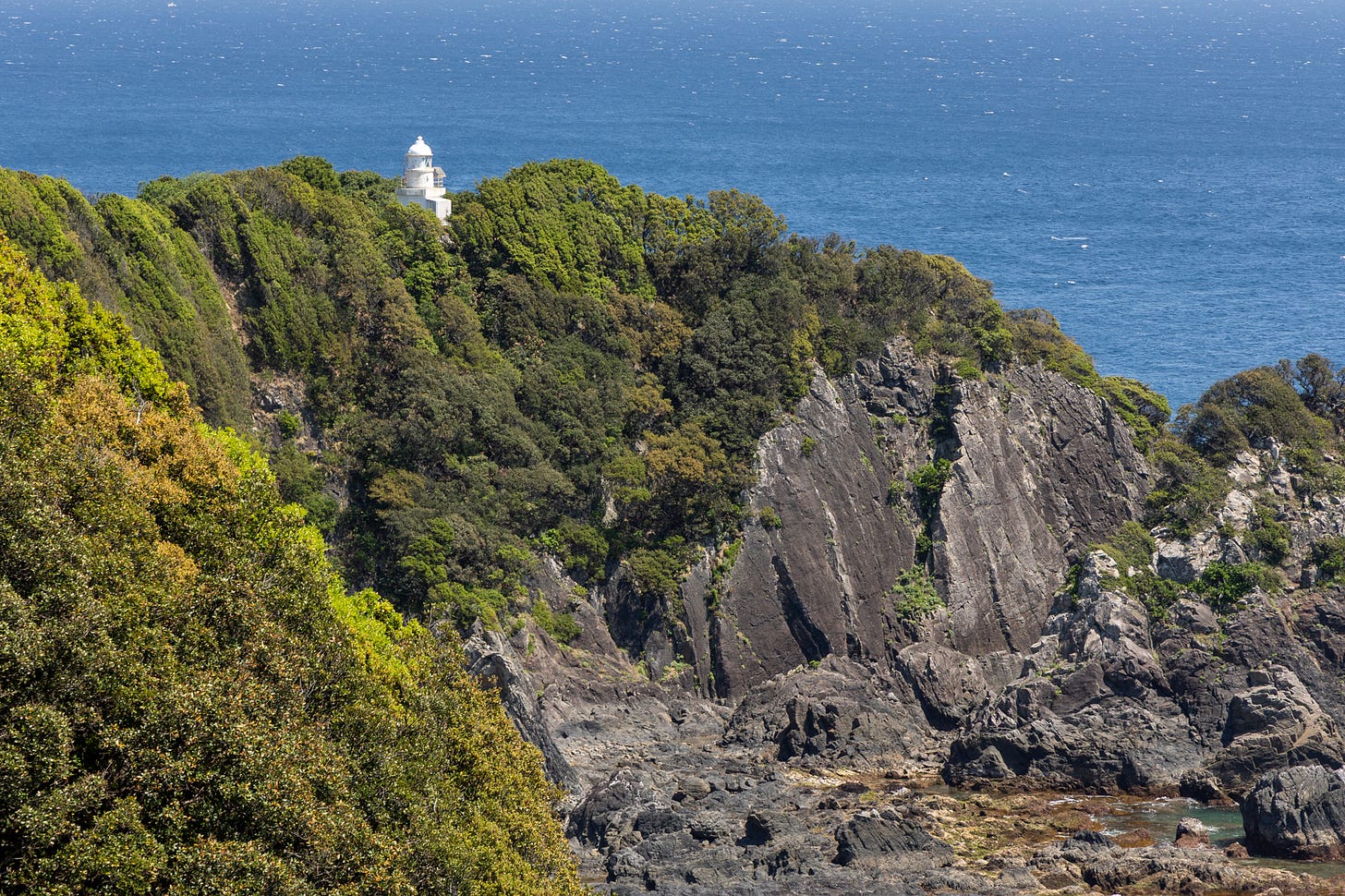
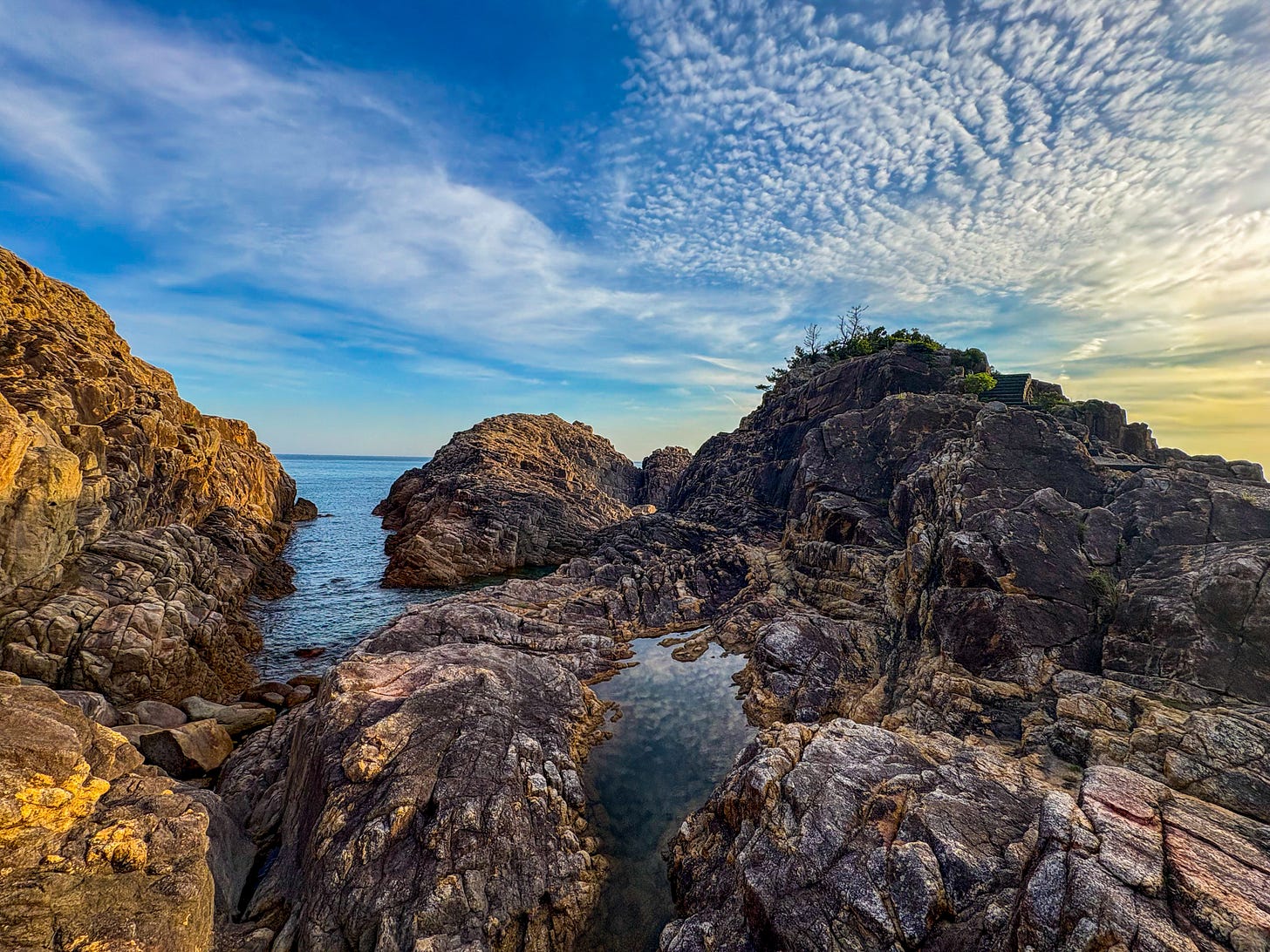
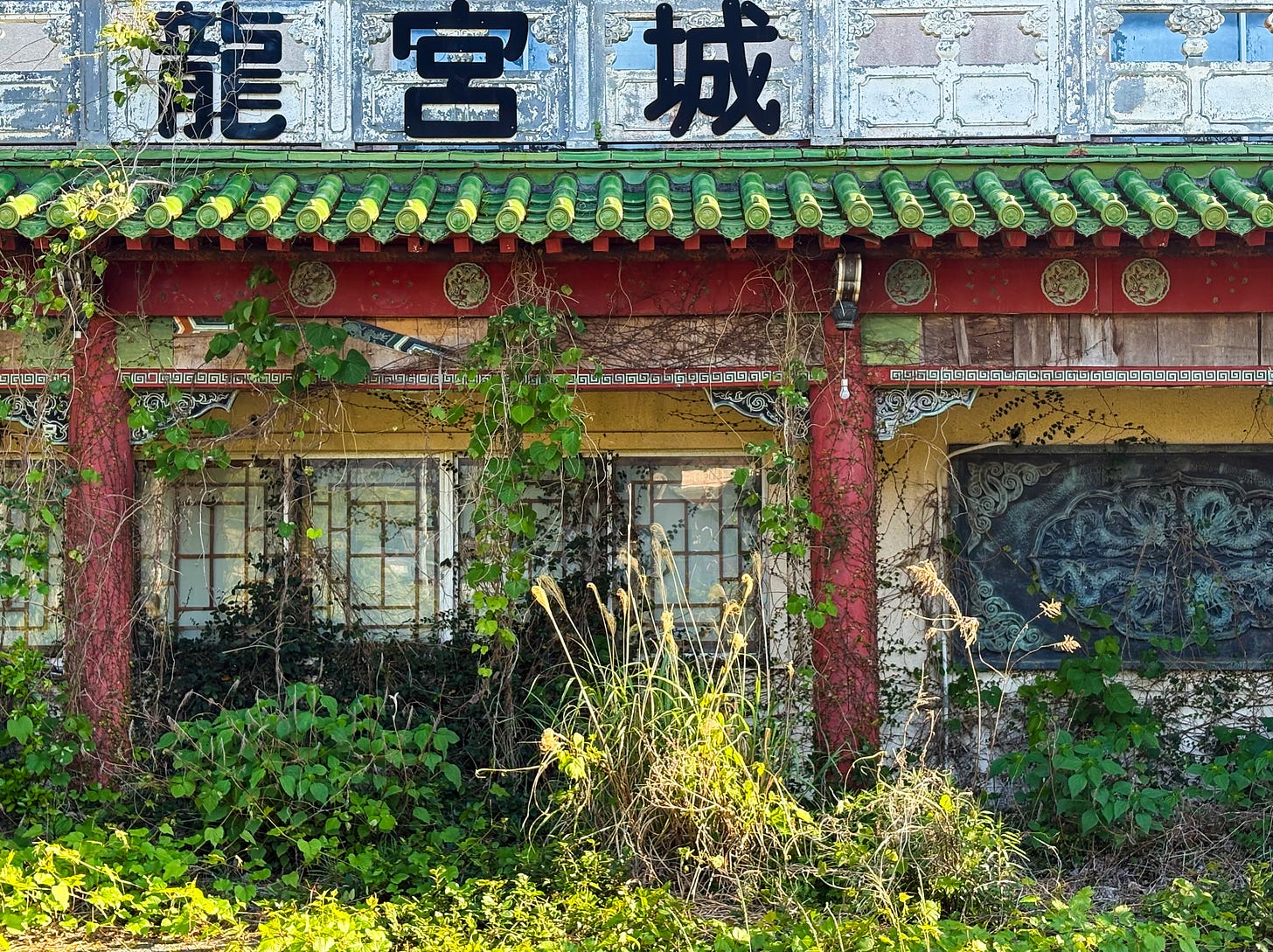
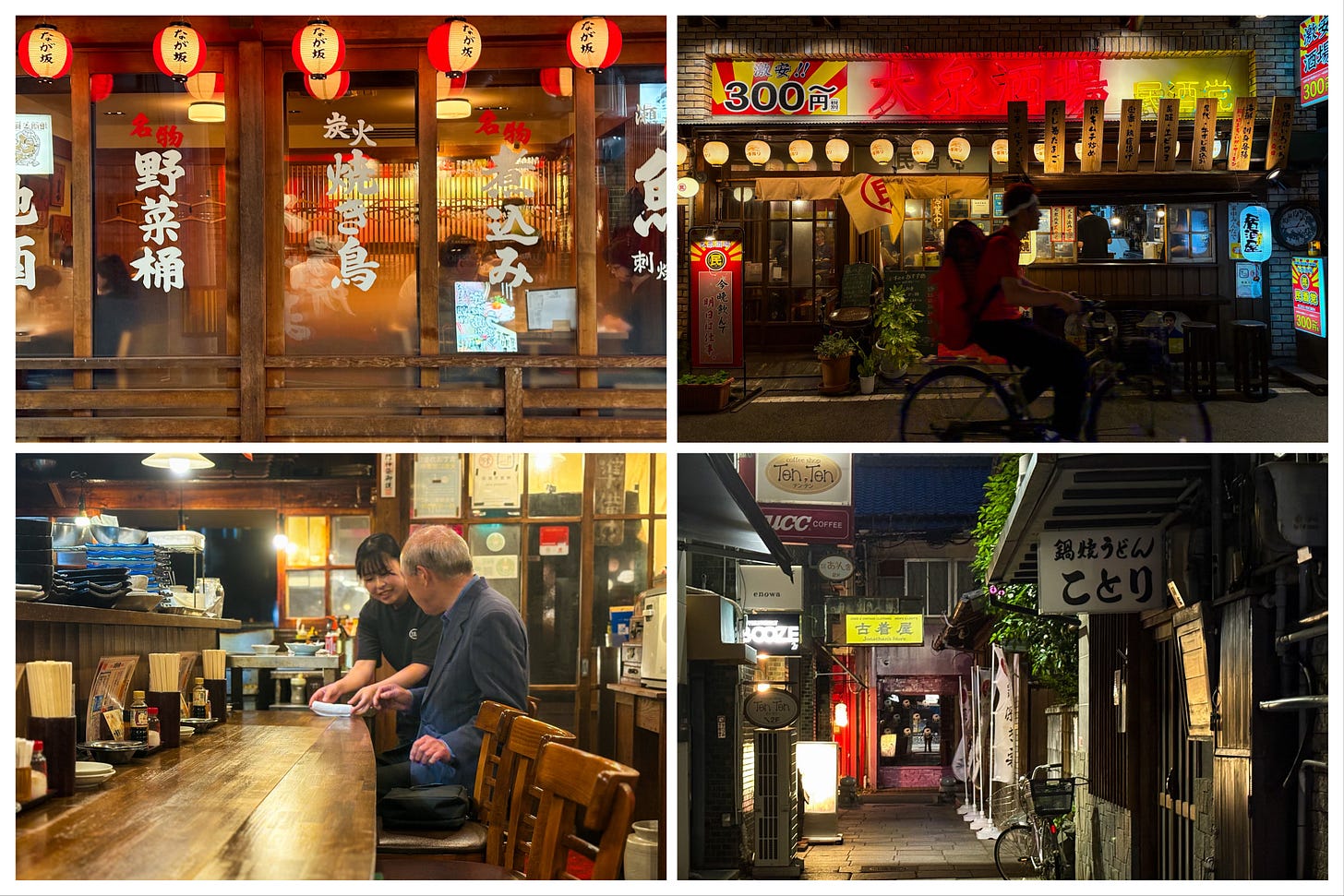
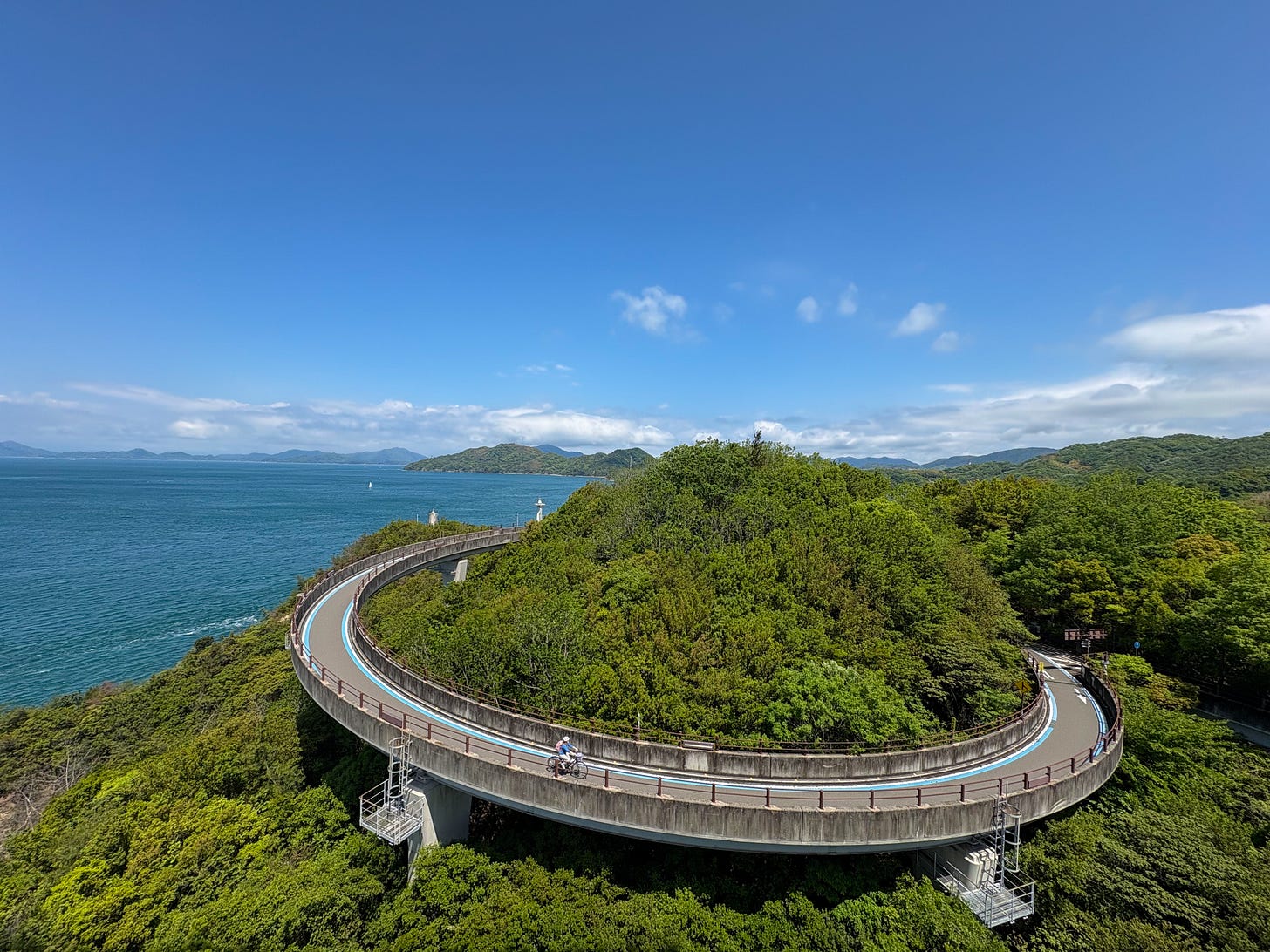
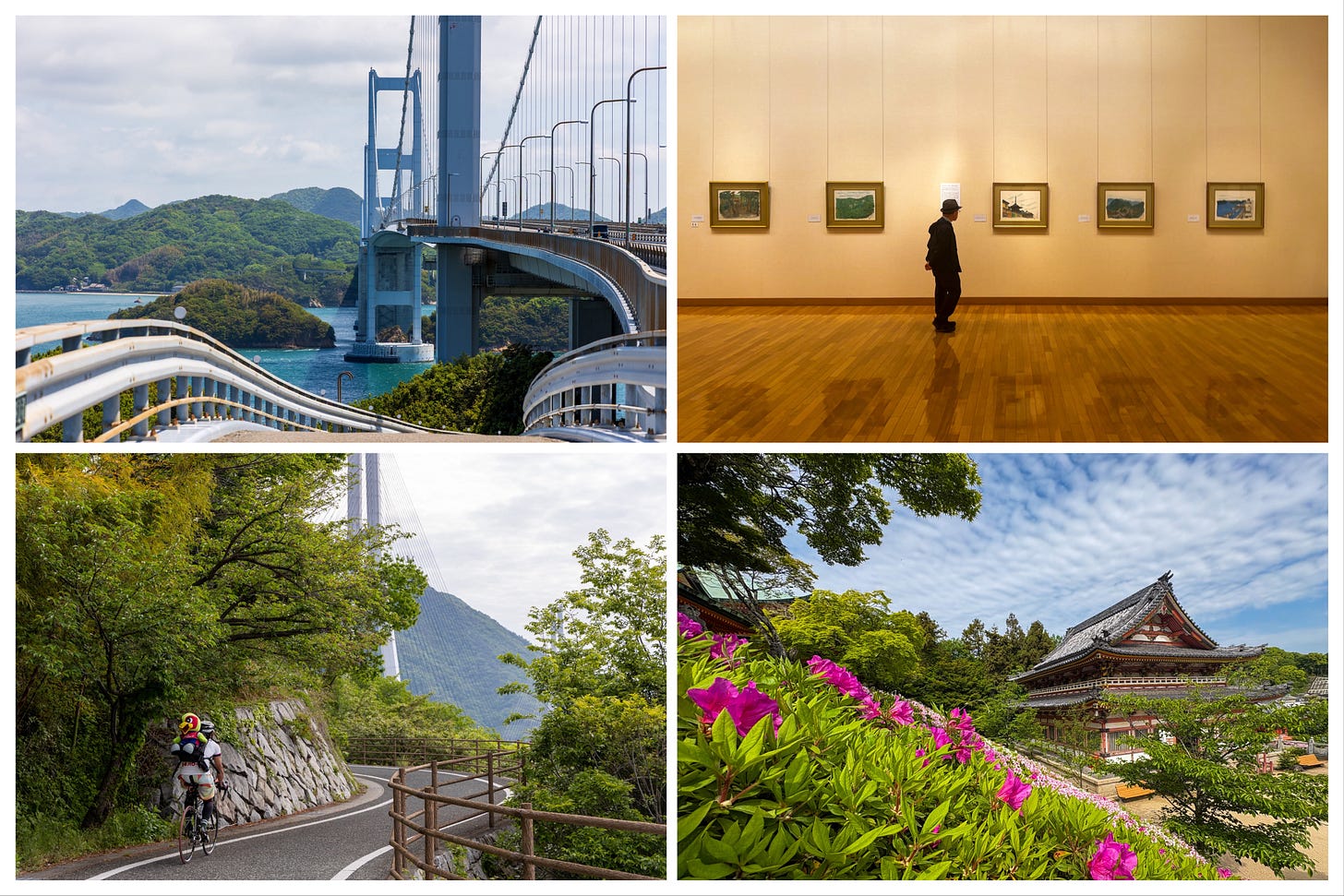
Gorgeous images and thoughts from Shikoku! It reminds me how Takamatsu is one of my favorite cities in the world. As a neighboring provincial capital, I guess it's probably a somewhat similar vibe. It is loved for many of the same reasons you liked Matsuyama. It just feels like a 'right sized' city, everything you need, alive but slower than the big cities, and not overcrowded.
Really intend to do the Shimanami Kaido some day. It was on my list when we were staying as artists for some months in Setouchi Triennale a long time ago (as was the Shikoku 88 temple pilgrimage). But we were too busy-minded to take time for it then.
After reading this, it's back on my list :-)
We were just in Onomichi and Tomonoura. Tomonoura is called Tomo ‘Nyan’ ( the Japanese equivalent of ‘meow’) by the residents because there are so many cats. Our hotel had a cat hostel built to house drop ins. Everyone feeds the cats and there is cat related art work and sculpture at every turn. Miyazaki stayed there for months developing his film Ponyo and used the town as inspiration for his locations. Here is link
https://tomonyahn.rwiths.net/r-withs/planListDetail.do?hotelNo=181102&GCode=&campID=5214639&vipCode=&f_lang=ja